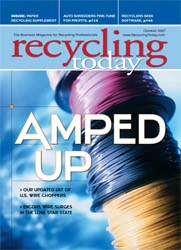Books have some serious reuse potential. For the avid recreational reader, a favorite story can be read over and over again for years or maybe even decades. But even when a book has been enjoyed for generations, what does one do with a dog-eared copy that’s so worn it’s unfit for rereading or other typical destinations for old books like garage sales or donation to a local library?
Trickier still are the nonfiction variety—old text books that have been rendered useless by new editions, outdated encyclopedias and other reference books. College bookstores support an entire niche industry of used book sellers, but even these products have a limited shelf life. However, while the information may be outdated, the book itself is still worth at least the paper it’s printed on.
Caraustar Recovered Fiber Group, Austell, Ga., has seized on the value of old books as a source of recovered fiber and is now collecting and recycling a variety of books to furnish its own mills as well as others.
RECOMMENDED READINGDrawing from her own experience in municipal recycling, Nancy Womack, a senior broker for Caraustar Recovered Fiber Group, says books have
|
SPREADING THE WORD |
|
While there are programs available to recycle books into usable recovered fiber grades, like the one Caraustar Recovered Fiber Group of Austell, Ga., has in place, traditional book recycling programs skew more toward reuse than the kind of recycling that involves material processing. A number of charitable organizations around the country collect books that have reached a kind of usefulness limbo: used, but still readable and perhaps unwanted by current owners. Hands Across the Water is one such organization—a non-profit group based in Massachusetts that collects used books in its home state as well as Connecticut, Rhode Island, Missouri, Washington and Georgia, and then ships them to schools and libraries around the world. More information is available at www.surplusbooksforcharity.org. |
Processing covers and dealing with binding and glue have been past hurdles to book recycling. However, with growing demand from new tissue mills in the United States and overseas, it’s more important than ever for recyclers to do some creative thinking when it comes to tapping new sources of recovered fiber, Womack says. "It’s extremely important," she says. "Mills are having to introduce new technology to run multiple grades of paper. The demand from the tissue mills continues to grow, especially domestically and especially in the South."
Caraustar buys all grades of books, from soft covers to hard cover textbooks to phone books, among others. Womack says the response to the collection program has been positive, with books coming from a variety of sources, including municipal recycling centers, waste paper packers, textbooks recyclers, printers, publishers, libraries and schools. "Books are coming from all over the country," she says.
The Athens-Clarke landfill in Georgia has joined Caraustar’s list of suppliers. The landfill started accepting hardcover books for recycling in August, according to a news story in the Athens Banner-Herald (Athens, Ga.).
The company typically picks up full loads of loose books in Gaylord boxes, which can hold some 40,000 pounds of loose books, according to Womack. Tim Kennedy, also from Caraustar Recovered Fiber Group, adds that the company also recieves some hardcover textbooks shipped stretch wrapped on pallets. "We can also pick up volumes in smaller straight trucks," he says.
Books can be used for multiple furnishes, Womack says, and not only to meet the fiber needs of tissue mills. For instance, Caraustar’s recycled paperboard mills use the product as well in making recycled paperboard grades.
In some cases, books have to be certified they will be destroyed. When needed, Caraustar issues certificates of destruction to printers and publishers that restrict books from being resold.
Cut books can be used for a wide variety of recycling applications, including recycled paperboard and recycled tissue, napkin and towel, according to information provided in a news release from Caraustar.
The book recycling program complements the Mill Group’s Binder Tex 45 product, a grade that is used specifically for hard cover book binding in hardbound textbooks, law books and library binding books. The volume of the Mill Group’s Binder Tex board is increasing, according to the company, which has the RFG optimistic about the future of the book recycling program, which Caraustar says closes the book, as well as the loop, on recycling.
MORE TO COMEThe book recycling program has only recently started, and response and participation have been positive so far, which is not surprising, says Womack, since the material has been available for some time and it was simply a matter of providing an outlet to collect it. "It’s something people just haven’t known what to do with," she says.
Response is continuing to grow, Womack adds. "We started during the busy season of school letting out, so we anticipate building our generation considerably by this time next year," she says. "We’re only at the tip of the iceberg," she adds.
The author is associate editor of Recycling Today and can be contacted at jgubeno@gie.net.
WANT MORE?
Enter your email to receive our newsletters.

Explore the October 2007 Issue
Check out more from this issue and find your next story to read.
Latest from Recycling Today
- Republic Services, Blue Polymers open Indianapolis recycling complex
- Altilium produces EV battery cells using recycled materials
- Brightmark enters subsidiaries of Indiana recycling facility into Chapter 11
- Freepoint Eco-Systems receives $50M loan for plastics recycling facility
- PET thermoform recycling the focus of new NAPCOR white paper
- Steel Dynamics cites favorable conditions in Q1
- Hydro starts up construction in Spain
- Green Cubes unveils forklift battery line





